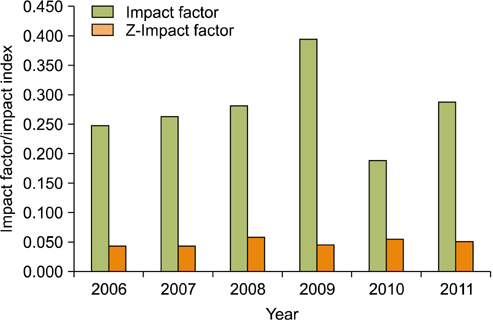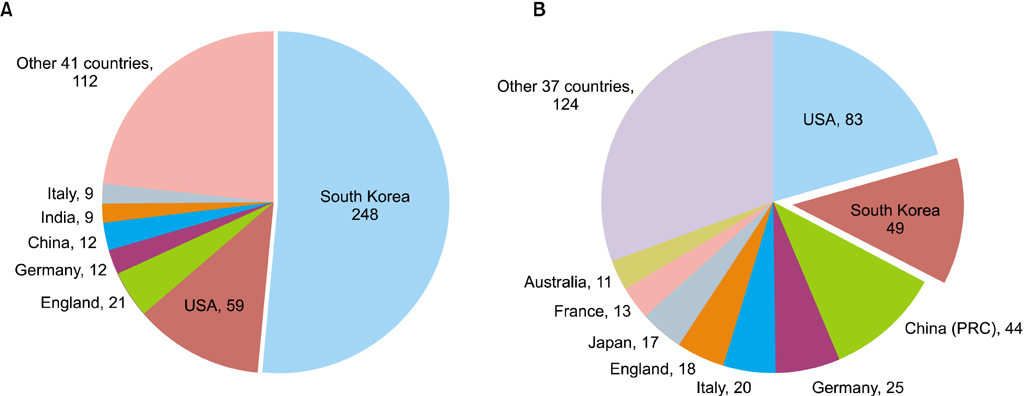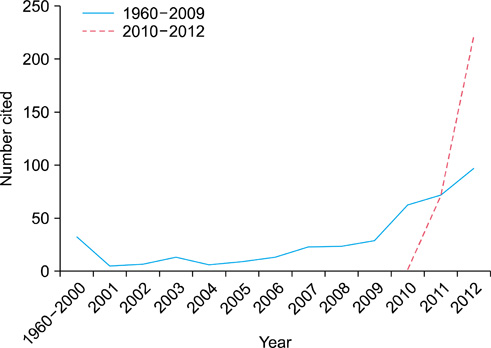Korean J Urol.
2013 Apr;54(4):220-228.
Citation Analysis of the Korean Journal of Urology From Web of Science, Scopus, Korean Medical Citation Index, KoreaMed Synapse, and Google Scholar
- Affiliations
-
- 1Department of Parasitology and Institute of Medical Education, Hallym University College of Medicine, Chuncheon, Korea. shuh@hallymac.kr
Abstract
- The Korean Journal of Urology began to be published exclusively in English in 2010 and is indexed in PubMed Central/PubMed. This study analyzed a variety of citation indicators of the Korean Journal of Urology before and after 2010 to clarify the present position of the journal among the urology category journals. The impact factor, SCImago Journal Rank (SJR), impact index, Z-impact factor (ZIF, impact factor excluding self-citation), and Hirsch Index (H-index) were referenced or calculated from Web of Science, Scopus, SCImago Journal & Country Ranking, Korean Medical Citation Index (KoMCI), KoreaMed Synapse, and Google Scholar. Both the impact factor and the total citations rose rapidly beginning in 2011. The 2012 impact factor corresponded to the upper 84.9% in the nephrology-urology category, whereas the 2011 SJR was in the upper 58.5%. The ZIF in KoMCI was one fifth of the impact factor because there are only two other urology journals in KoMCI. Up to 2009, more than half of the citations in the Web of Science were from Korean researchers, but from 2010 to 2012, more than 85% of the citations were from international researchers. The H-indexes from Web of Science, Scopus, KoMCI, KoreaMed Synapse, and Google Scholar were 8, 10, 12, 9, and 18, respectively. The strategy of the language change in 2010 was successful from the perspective of citation indicators. The values of the citation indicators will continue to increase rapidly and consistently as the research achievement of authors of the Korean Journal of Urology increases.
Keyword
MeSH Terms
Figure
Reference
-
1. Bjork BC, Solomon D. Open access versus subscription journals: a comparison of scientific impact. BMC Med. 2012. 10:73.2. Web of Science [Internet]. c2013. cited 2013 Feb 2. Philadelphia: Thomson Reuters;Available from: http://www.webofknowledge.com/wos/.3. Scopus [Internet]. c2013. cited 2013 Feb 2. Amsterdam: Elsevier B.V.;Available from: http://www.scopus.com/.4. SCImago Journal & Country Rank [Internet]. c2007-2013. cited 2013 Feb 2. Madrid: Scimago Lab;Available from: http://scimagojr.com/.5. KoMCI [Internet]. c2011. cited 2013 Feb 2. Seoul: Korean Academy of Medical Science;Available from: http://komci.org/.6. KoreaMed Synapse [Internet]. c2011. cited 2013 Feb 2. Seoul: Korean Association of Medical Journal Editors;Available from: http://synapse.koreamed.org/.7. Google Scholar [Internet]. c2013. cited 2013 Feb 2. Seattle: Google Co.;Available from: http://scholar.google.com/.8. Hirsch JE. An index to quantify an individuals scientific research output. Proc Natl Acad Sci U S A. 2005. 102:16569–16572.9. Huh S. Citation analysis of The Korean Journal of Internal Medicine from KoMCI, Web of Science, and Scopus. Korean J Intern Med. 2011. 26:1–7.
- Full Text Links
- Actions
-
Cited
- CITED
-
- Close
- Share
- Similar articles
-
- Medical Database Search
- Citation Analysis of The Korean Journal of Internal Medicine from KoMCI, Web of Science, and Scopus
- How far has The Korean Journal of Internal Medicine advanced in terms of journal metrics?
- Subspecialty Variation in Academic Citations of Orthopedic Surgery Publications
- Journal Metrics-Based Position of Diabetes & Metabolism Journal after the Change of Its Text Language to English








